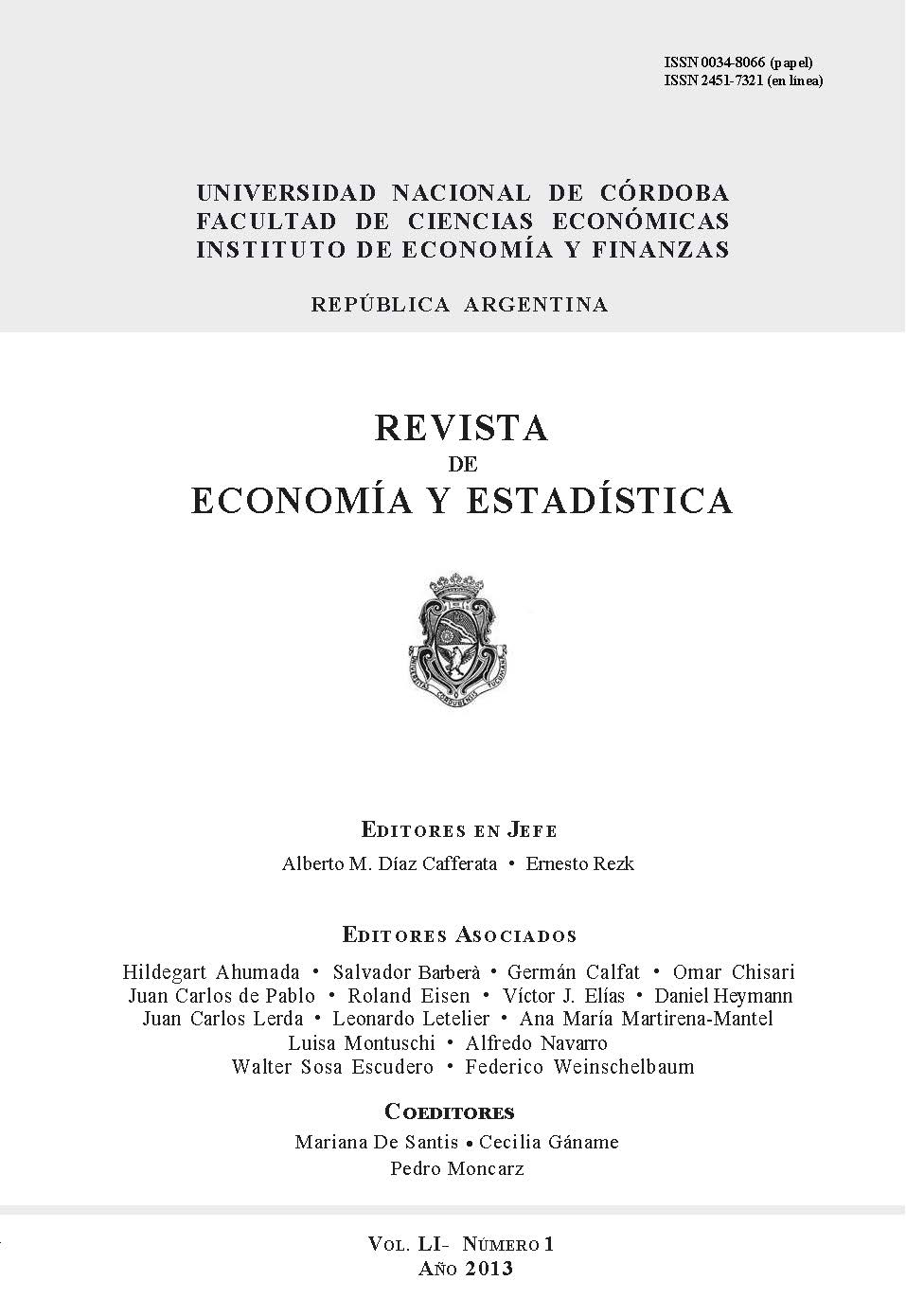Pension Regimes in Latin American Emerging Countries: Do and Can Individual Capitalization Schemes and PAYG Systems Coexist?
DOI:
https://doi.org/10.55444/2451.7321.2013.v51.n1.11879Keywords:
individual capitalization, PAYG, non contributory regimes, coverage, tax compliance, financial sustainabilityAbstract
Experts have been pointing out that, although fully funded pension schemes implemented by several Latin American countries gathered political rejection and experienced important setbacks, they were resorted to in response to the problems faced in the eighties and the nineties by unfunded regimes. In this connection, the idea is that both individual capitalization and PAYG systems can and should coexist provided that efficacy in ensuring expected levels of coverage, equity and efficiency and in guaranteeing also long run financial sustainability be appropriately reached. Nevertheless, several preconditions appear necessary for the preceding scenario to be possible: coverage and tax compliance need to be expanded in both regimes particularly to include the self employed workers, individual capitalization needs be improved and turned more attractive by reducing administrative and commercial costs and by offering a more varied portfolio composition concerning instruments and risk levels. Finally, despite that competition between regimes, by permitting affiliates to switch from one to another, promotes efficiency, non contributory pensions will still be necessary, on grounds of distributional, solidarity and equity goals.
Downloads
References
Acuña, R. (Ed.) (2013). Contribución del sistema privado de pensiones al desarrollo económico de Latinoamérica. Experiencias de Colombia, México, Chile y Perú. SURA Asset Management.
Asociacion Internacional de Organismos de Supervision de Fondos de Pensiones (AIOS) (2004). “Los Regímenes de Capitalización Individual en América .Latina. Boletín Estadístico Nº 12.
Ando, A. and Modigliani F. (1963). “The ´Life Cycle´ Hypothesis of Saving: Aggregate Implications and Tests”. American Economic Review 53, March, pp. 55-84.
Bailliu, J. and Reisin H. (1997). “Do Funded Pensions Contribute to Higher Aggregate Savings: A Cross-Country Analysis”. Working Paper No. 130, OECD Development Centre, Paris.
Blinder, A. S. (1982). “Private Pensions and Public Pensions: Theory and Fact”. Working Paper No. 902, National Bureau of Economic Research. Cambridge, Ma.
Boadway, R. and Cuff K. (2005). “Evaluating Public Pensions”, in Public Expenditure Analysis, A. Shah Ed.,.The World Bank, Washington, pp. 69-133.
Bertranou, F., Calvo, E. and Bertranou E. (2009). “¿Está Latinoamérica alejándose de las cuentas individuales de pensiones?”. Center for Retirement Research, Nº 9-14.
Cagan, P. (1965). “The Effect of Pension Plans on Aggregate Savings”. NBER, New York.
Corsetti, G. and K. Schmidt-Hebbel (1996). “Pension Reform and Growth”, in Pensions: Funding, Privatization and Macroeconomic Policy, S. Valdés-Prieto Ed., Cambridge University Press.
David, P. A. and Scadding J. L. (1974). “Private Savings: Ultrarationality, Aggregation and Denison´s Law”. Journal of Political Economy, March/April, pp. 225-249.
Faruqee, H. and Husain A. M. (1994). “Determinants of Private Saving in Southeast Asia: A Cross-Country Analysis”, South East Asia and Pacific Department, International Monetary Fund, Washington, D.C.
Feldstein, M. (1974). “Social Security, Induced Retirement, and Aggregate Capital Accumulation”, Journal of Political Economy, Vol. 82, No. 5, pp. 905-925.
Greene, W. H. (2007). Econometric Analysis, Prentice Hall, USA, Cap. 9.
Katona, G. (1964). Private Pensions and Individual Savings. Ann Arbor: Survey Research Center, Institute for Social Research, University of Michigan.
Mesa-Lago, C. (2005). “Assessing the World Bank Report Keeping the Promise”. International Social Security Review, 58(2-3), pp. 97-117.
Morande, F. (1996), “Savings in Chile: What Went Right?”, Inter-American Development Bank Working Paper No. 322, Washington, D.C.
Raddatz, C. and Schmukler S. (2008). “Pension Funds and Capital Market Development: How much bang for the buck”. Policy Research Working Paper 4787, The World Bank, Washington D.C.
Reisin, H. (1997). “Liberalizing Foreign Investments by Pension Funds: Positive and Normative Aspects”. Working Paper No. 120, OECD Development Centre, Paris.
Rezk, E., Irace, M. and Ricca V. (2009). “Pension funds´ contribution to the enhancement of aggregate private saving: A panel data analysis for emerging economies”. Annals of the 11º Fiscal Policy Workshop, Banca d´Italia, Perugia.
Roffman, R. and Lucchetti L. (2006). “Pension Systems in Latin America: Concepts and Measurement of Coverage”. Social Protection Discussion Paper 0616, World Bank, Washington, D.C.
Downloads
Published
Issue
Section
License
Copyright (c) 2013 Ernesto Rezk

This work is licensed under a Creative Commons Attribution-NonCommercial-NoDerivatives 4.0 International License.
Authors who have publications with this journal agree to the following terms:
Authors retain their copyright and grant the journal the right of first publication of their work, which is simultaneously subject to the Creative Commons Attribution-NonCommercial-NoDerivatives 4.0 International License that allows third parties to share the work provided that its author and first publication in this journal are indicated.
Authors may adopt other non-exclusive licensing arrangements for distribution of the published version of the work (e.g. depositing it in an institutional telematic archive or publishing it in a monographic volume) as long as the initial publication in this journal is indicated.
Authors are allowed and encouraged to disseminate their work via the Internet (e.g. in institutional telematic archives or on their website) before and during the submission process, which can lead to interesting exchanges and increase citations of the published work. (See The Open Access Effect)










